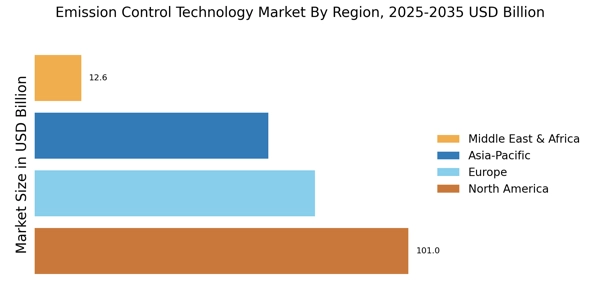Growth of the Automotive Sector
The growth of the automotive sector significantly influences the Emission Control Technology Market. With the rise in vehicle production and sales, particularly in emerging markets, there is a corresponding increase in the demand for effective emission control technologies. The automotive industry is under pressure to comply with stringent emission standards, which has led to the adoption of advanced technologies such as exhaust gas recirculation (EGR) and particulate filters. Market forecasts suggest that the automotive segment will account for over 40% of the total emission control technology market by 2026, highlighting the critical role of this sector in driving market expansion.
Investment in Renewable Energy Sources
Investment in renewable energy sources is emerging as a key driver for the Emission Control Technology Market. As nations transition towards cleaner energy solutions, there is a growing need for technologies that can effectively manage emissions from both traditional and renewable energy sources. The integration of emission control technologies in power generation facilities is essential for meeting environmental standards. Recent data indicates that investments in renewable energy are expected to reach USD 1 trillion by 2025, which will likely create substantial opportunities for emission control technology providers. This trend reflects a broader commitment to sustainability and the reduction of carbon footprints across various industries.
Increasing Stringency of Emission Regulations
The Emission Control Technology Market is experiencing a notable surge due to the increasing stringency of emission regulations across various sectors. Governments are implementing stricter standards to combat air pollution and climate change, which compels industries to adopt advanced emission control technologies. For instance, the European Union has set ambitious targets for reducing greenhouse gas emissions, which has led to a projected growth rate of approximately 7% in the emission control technology sector over the next five years. This regulatory pressure not only drives innovation but also encourages companies to invest in cleaner technologies, thereby expanding the market for emission control solutions.
Rising Environmental Awareness Among Consumers
The Emission Control Technology Market is also benefiting from the rising environmental awareness among consumers. As public concern regarding air quality and climate change intensifies, consumers are increasingly favoring products and services that demonstrate a commitment to sustainability. This shift in consumer behavior is prompting manufacturers to invest in emission control technologies to enhance their environmental credentials. Market data indicates that companies adopting sustainable practices can experience a 10% increase in customer loyalty. Consequently, the demand for emission control solutions is likely to grow as businesses seek to align with consumer expectations and regulatory frameworks.
Technological Advancements in Emission Control
Technological advancements play a pivotal role in shaping the Emission Control Technology Market. Innovations such as selective catalytic reduction (SCR) and advanced filtration systems are enhancing the efficiency of emission control devices. The integration of artificial intelligence and machine learning into these technologies is enabling real-time monitoring and optimization of emissions, which is likely to improve compliance rates significantly. As industries strive to meet regulatory requirements, the demand for cutting-edge emission control technologies is expected to rise, potentially leading to a market growth of around 8% annually. This trend underscores the importance of continuous research and development in the emission control sector.


















Leave a Comment